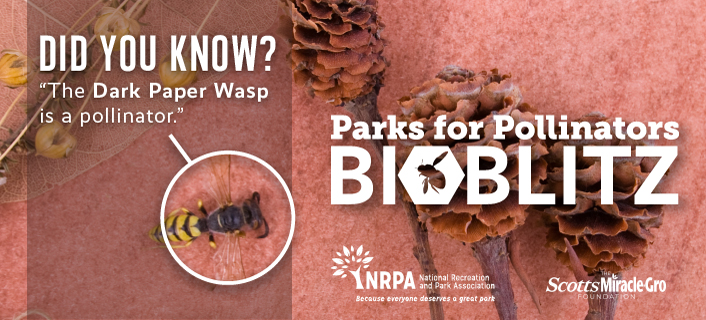Parks for Pollinators is a national campaign focused on raising public awareness of the current pollinator crisis by encouraging local action and positioning parks as a national leader in advancing pollinator health, native habitat and sustainability practices. This campaign continues to assess the public’s understanding of pollinators, to outline actions to protect them and to increase local park and recreation agencies’ capacity to promote pollinator protection within parks and to engage and educate their communities on what they can do to help.
What's Happening to Pollinators?
Pollinators are essential to our ecosystem. Over 75% of the world's flowering plants and 35% of the world's crops rely on pollinators. Did you know that one out of every three bites of food you eat is there because of pollinators? They not only are essential for our food production but also support healthy ecosystems.
Communities should have special places to support pollinators. But many people don’t know how they can help, although they would if they could learn how.
Pollinator species have declined in numbers, become endangered or even gone extinct due to the loss of natural food supplies and habitat. Their recovery can occur through the creation and restoration of native habitats across the country in public spaces along with educating communities on how they can help. Parks, as pillars in their community, are vital in creating this change. Join us in supporting pollinators nationwide and do your part to help!
Multiple Benefits of Pollinator Habitat
Did you know that pollinator habitat and native plants do much more than support pollinators? Pollinators and their habitats:
- Increase ecological resilience of communities
- Increase sustainability practices in parks
- Improve water quality by filtering stormwater and runoff
- Reduce the heat island effect
- Are low maintenance and water-efficient
- Provide many more wonderful benefits
Parks for Pollinators Support
Your parks can support pollinators by making your best effort to:
- Plant a variety of pollinator-friendly flowers that bloom from spring through fall and grow as many native plants as possible (especially milkweed).
- Avoid using insecticides and herbicides, which may kill pollinators or the plants they rely on. We will try an integrated pest management (IPM) or the organic land management (OLM) approach.
- Educate our community on steps they take to help pollinators.
- Create or update a pollinator protection and sustainability strategy for our agency or community.
Parks for Pollinators BioBlitz

Join us to raise awareness of pollinators nationwide by hosting a Parks for Pollinator BioBlitz in your community during the month of September. In September 2024, NRPA will be hosting the sixth annual Parks for Pollinators BioBlitz. Sign up now!
Learn More
Resources
Parks and Pollinators: Taking Action and Advancing Sustainability resource helps agency’s leverage their current efforts with native habitat and create plans that more effectively advance their work with native habitat and sustainability efforts. This resource offers a guided self-assessment, process to create a team, curated resources, sample policies and practices, and ways to engage your community and building awareness. These tools can create momentum for your current sustainability and biodiversity efforts and create a core team to advance this work in the future.
BioBlitz toolkit: This toolkit will help you plan, execute and evaluate your BioBlitz! It contains everything you need to set up your event through iNaturalist and even provides extra complimentary activities too.
Pollinator Protection and Outreach Strategies: Multiple Methods that Make a Difference. This webinar highlights best practices and methods to create a pollinator protection strategy and outreach plan in your community.
Parks Play a Vital Role in Saving Pollinators: This information provides national research on the public’s support of pollinator issues and their knowledge of how they can help.
"Columbus Recreation and Parks Department Celebrates Earth Month": In this NRPA Open Space blog post, learn how the department celebrates Earth Month 2021 by planting pollinator habitats.
“Becoming “Green Stewards”: How the BioBlitz Is Getting Residents Across the South Invested in Their Parks”: This blog explores how two different park agencies are leveraging the Bioblitz to increase community engagement.
BioBlitz Story Map. Pollinators include many different types of species, not only the monarch butterfly and bumblebee but also beetles, wasps and moths (and bats and hummingbirds). Explore the story map below to find out where these pollinators live and the plants they like best.
Contact the NRPA Resilience team with any questions.


